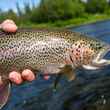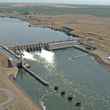In those days the shore lunch went into the boat in two parts. There was the sturdy wooden box, painted forest green, with the hinged top, the hook-and-eye latch, and the rope handles on both ends. This went in the stern, next to where the guide sat, and it held the eating utensils, the cans of pork-and-beans, the bricks of lard, the breading and seasonings for the fish—everything except the cookware. That went into a burlap sack, which was tucked up under the bow.
This cookware, all blackened by the smoke of countless wood fires, included a coffee pot, a pot for heating the beans, and at least two capacious cast iron skillets—one for the fish, one for the sliced potatoes and onions. It’s been a long time, but I can still see the walleye fillets bubbling around the edges as they turned to gold, still hear the lard’s ferocious sizzle, still smell those ambrosially evocative aromas of fish, onions, and potatoes being fried.
And I can still feel their effect on an appetite whetted by a morning on the water, the air bracingly cool, the sky impossibly blue, the North Country stretching as far as the imagination can dream.
Of course we would eat ourselves into a stupor, a stupor aided and abetted by at least one and possibly two bottles of ice-cold Labatt’s. While we groaned and attempted to rouse ourselves, the guide would pad down to the water’s edge, scoop up a handful of sand, and scour the skillets clean. It took so little time, and appeared so effortless, that it seemed a kind of Northwoods voodoo. The skillets came out gleaming, like black armor, and after drying they went directly into the burlap sack. Nothing more needed to be done.
They were ready for the day to come, ready for their next fierce tryst with fat and fire.
Cooking with cast iron is all the rage right now. The feeling among the “foodie” crowd seems to be that the cast iron skillet’s been rediscovered. This is amusing to those of us raised on shore lunches and camp cooking, because in our world cast iron never went away. It’s always been the standard by which all cookware is judged.
A cast iron skillet is solid functionality. It heats up quickly but not too quickly, and it holds onto it tenaciously. It can go from the stovetop to the oven to the cookfire; you can use it to sear, sauté, roast, bake, braise, stew, smother—pretty much any technique you can think of. Apple pie cooked in cast-iron over indirect heat in a Weber kettle? Oh yes oh yes oh yes.
Nothing compares to cast iron for baking cornbread, frying chicken, or, for that matter, frying, period. Once or twice a year I creel a mess of brook trout for the pan—“release to the grease,” as they say—and there’s only one pan in my battery that’s worthy of them. When we’re done feasting there isn’t enough left on our plates to turn the head of a seagull.
Personally I’m of the opinion that cast iron is also the best medium for cooking steak, venison steak in particular. A smoking-hot cast iron skillet allows you to put that intensely flavorful crust on a steak that you just can’t duplicate on the grate of a grill. It also gives you the option of making a sauce with the pan juices, which needn’t be any more complicated than adding a healthy glug of red wine and a couple squirts of Worcestershire, whisking it up, and letting it cook down a bit.
A pat of butter and a splash of cream never hurt, of course.
Cast iron has that pleasingly authoritative heft, too, which is something we sportsmen appreciate in our tools. When you pick up a cast iron skillet, there’s no doubt it means business. To paraphrase a quip I once heard, If you want to fly, you want something made of aluminum. If you want to fry, you want something made of iron.
Given proper care, a cast iron skillet will last indefinitely. The thing is, proper care for cast iron involves occasional feeding. Cast iron is porous, and in order to develop and maintain that desirably satiny surface it needs to be “seasoned.” There are any number of recipes for seasoning cast iron but they all boil down to putting a quantity of oil or shortening in the pan, adding heat (most recipes suggest a low oven in the 250°-300° range), and essentially baking it in.
In the normal course of culinary events your skillet will get enough supplemental feeding from the things you cook in it—bacon, for example—to render full-blown re-seasoning unnecessary.
Still, it never hurts to slick up the inside of the pan with a drop or two of oil before you put it away.
Of course the cardinal rule of cleaning cast iron is that soaps and detergents must never, ever touch it. They strip the seasoning from the pores of the pan and replace it with their own perfumy residue—the ultimate horror to cast iron devotees.
Truth to tell, sand is frowned upon as a cleanser by many in the cast iron camp. This is faintly ironic (heh, heh) given that cast iron cookware is literally born from the stuff. In a process that hasn’t changed much since the mid-19th century, molten iron is poured into sand molds; then, when the iron has cooled sufficiently, the sand is broken off and the rough-cast implement is de-burred and polished.
As recently as 20 years ago there were several American companies making cast iron cookware. Today, the only major player is the Lodge Company of Tennessee. This contraction isn’t surprising, really, when you consider that the product is essentially unimprovable and that it never wears out. There is no “planned obsolescence” built into a cast iron skillet.
It’s also the case that there’s a vast supply of used but fully functional cast iron cookware for sale in antiques stores, thrift shops, and the like. Some of the collectible stuff can be a little pricey but a typical cast iron skillet will set you back less than one of those fancy insulated mugs you’ve been eyeing up at the fly shop. It’ll last a lot longer, too—longer than you will, in all probability.
This brings up one final thought, a sort of mantra among the cast iron faithful: A little rust won’t kill you.
































Comments
toadfish replied on Permalink
We almost always bring the iron skillet on camping trips when we don't need to travel light. Nothing works better. I've cleaned with sand, and it does no harm that I've ever noticed. Usually though I use my Irish mothers trick; coarse salt to clean any tough burnt on spots. I think that both methods are effective because they are abrasive enough but coarse enough to not clean the pores of the iron. You don't need to rub very hard for it to work.
To recondition a pan with a lumpy, sticky surface, she would put the pan in a hot fire for a few minutes until the thick old coating ignited and burnt off. She would pull the pan out, let it cool for a minute, then put on some oil or lard and wipe it with a rag. It was good as new.
She said that they once cooked with one on a hot car engine. Can't be sure it wasn't blarney, but my uncle also tells the story.....
Pages